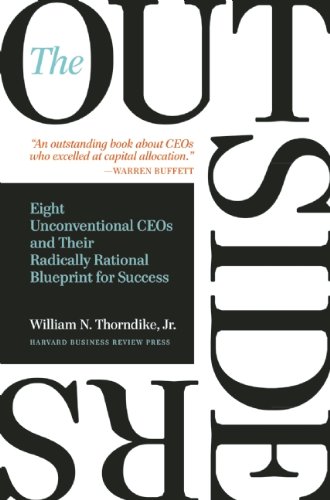

This article is an excerpt from the Shortform summary of "The Outsiders" by William N. Thorndike, Jr. Shortform has the world's best summaries of books you should be reading.
Like this article? Sign up for a free trial here .
What is Teledyne, and why is the company featured in The Outsiders as one of the most successful companies of all time?
Teledyne is an industrial conglomerate founded in 1960, currently involved in businesses ranging from aerospace electronics to digital imaging. CEO Henry Singleton was the founder and its CEO until 1991. Under Henry Singleton’s leadership, Teledyne saw significant growth.
Learn about Teledyne and how Henry Singleton helped it becomes successful.
Teledyne: From New Company to Conglomerate
Henry Singleton served as Teledyne’s CEO from 1960 to 1986, taking it through three phases with very different activities:
- Rapid expansion of the conglomerate through acquisitions
- Aggressively buying back shares with the company’s free cash flow
- Spinning out its subsidiaries when performance began stagnating
Teledyne Performance
From 1963 to 1990, Teledyne showed a 20.4% annual return rate, compared to 11.6% for the S&P 500 and 11.6% for major conglomerates.
$1 invested at the beginning would have been worth $181 by 1990. This outperformed the S&P by 12 times, and his peers by nearly 9 times.
Teledyne History
Henry Singleton was born in 1916. He attended MIT for college and received a PhD in electrical engineering. He won first place in the Putnam Math Competition and was nearly a chess grandmaster—clearly a smart guy.
After graduating, he became a research engineer at a series of aviation companies. At Litton Industries, he led a business group that grew to $80 million in revenue and became the company’s largest division.
In 1960, at age 43, he left Litton to co-found Teledyne with a colleague. They began by acquiring three electronics companies and using this platform to win a large naval contract. Within a year, they became a public company.
In this era of conglomerates, companies expanded quickly through acquisitions. Since private equity didn’t yet exist, there was less competition for acquisitions, and acquired companies often traded for lower P/E multiples than their buyers had in public markets. As a result, conglomerates had a virtuous cycle for acquisitions—buying cheap companies raised short-term profits, which increased stock prices, which in turn was used to buy more companies.
Singleton took advantage of these dynamics. In 8 years ending in 1969, he purchased 130 companies in a wide range of industries, including specialty metals and insurance. Most companies were purchased using Teledyne stock.
In 1967, Singleton acquired Vasco Metals and promoted its president (and Singleton’s former roommate at the Naval Academy) George Roberts to president of Teledyne. As with Burke at Capital Cities, Roberts became the operating manager of Teledyne, freeing up Singleton to focus on strategy and capital allocation.
In 1969, Teledyne’s stock began falling in P/E ratio, and acquisition prices began rising. Realizing that Teledyne’s stock would no longer be profitable for acquisitions, he laid off his acquisition team and never made another material acquisition. Instead, they turned their focus to increasing margins at business units. Through the 1970s and 1980s, Teledyne saw remarkably high return on assets of 20% or greater.
This generated remarkable free cash flow, which was used by Singleton in a series of aggressive share repurchases. At the time, the conventional wisdom held that repurchases were done only by weak companies that lacked investment opportunities. But given Teledyne’s low P/E ratio and high acquisition prices, Singleton reasoned that the best use of cash was to repurchase shares. Over 12 years, he bought back a staggering 90% of Teledyne’s shares, becoming a pioneer in share repurchases as a financial strategy. As a result of share repurchases, from 1971 to 1984, Teledyne’s earnings per share grew by 40-fold.
From 1984, Singleton began planning for his succession (he promoted Roberts to CEO in 1986). By this time, Henry Singleton’s Teledyne had begun showing stagnating results. Singleton’s approach here, as usual, was unconventional—he began unpacking the Teledyne conglomerate, spinning off companies to be independent. For example, in 1990, he spun off Unitrin, Teledyne’s largest insurance business and the majority of Teledyne’s company value. He believed disassembling the conglomerate would reduce Teledyne’s complexity, thus reducing succession issues, as well as unlock more value for shareholders.
Finally, in 1987, Singleton paid Teledyne’s first dividend in its 26 years as a public company. The reasoning: stock prices and acquisition prices were at historic highs, while Teledyne’s non-insurance companies were in a slump, and so he reasoned distributing cash flow to shareholders was the best use of money.
Singleton retired in 1991, having realized a 20% compounded annual growth rate over the 30 years as a public company.
For Henry Singleton, Teledyne was the company he founded and spent his life working on. His successes at Teledyne show that his business strategy and dedication paid off.

———End of Preview———
Like what you just read? Read the rest of the world's best summary of William N. Thorndike, Jr's "The Outsiders" at Shortform .
Here's what you'll find in our full The Outsiders summary :
- What great CEOs like Warren Buffett do that average CEOs don't
- How to master the art of capital allocation
- How to be a great manager that your team is excited to work with






